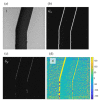Neural Network for Enhancing Microscopic Resolution Based on Images from Scanning Electron Microscope
- PMID: 33803876
- PMCID: PMC8003193
- DOI: 10.3390/s21062139
Neural Network for Enhancing Microscopic Resolution Based on Images from Scanning Electron Microscope
Abstract
In this paper, an artificial neural network is applied for enhancing the resolution of images from an optical microscope based on a network trained with the images acquired from a scanning electron microscope. The resolution of microscopic images is important in various fields, especially for microfluidics because the measurements, such as the dimension of channels and cells, largely rely on visual information. The proposed method is experimentally validated with microfluidic structure. The images of structural edges from the optical microscope are blurred due to optical effects while the images from the scanning electron microscope are sharp and clear. Intensity profiles perpendicular to the edges and the corresponding edge positions determined by the scanning electron microscope images are plugged in a neural network as the input features and the output target, respectively. According to the results, the blurry edges of the microstructure in optical images can be successfully enhanced. The average error between the predicted channel position and ground truth is around 328 nanometers. The effects of the feature length are discussed. The proposed method is expected to significantly contribute to microfluidic applications, such as on-chip cell evaluation.
Keywords: artificial neural network; image enhancement; microfluidics; microscope.
Conflict of interest statement
The authors declare no conflict of interest.
Figures

















References
-
- Verschueren H. Interference reflection microscopy in cell biology: Methodology and applications. J. Cell Sci. 1985;75:279–301. - PubMed
-
- Horade M., Tsai C.-H.D., Ito H., Kaneko M. Red Blood Cell Responses during a Long-Standing Load in a Microfluidic Constriction. Micromachines. 2017;8:100. doi: 10.3390/mi8040100. - DOI
-
- Tsai C.-H.D., Sakuma S., Arai F., Taniguchi T., Ohtani T., Sakata Y., Kaneko M. Geometrical alignment for improving cell evaluation in a microchannel with application on multiple myeloma red blood cells. RSC Adv. 2014;4:45050–45058. doi: 10.1039/C4RA08276A. - DOI
Grants and funding
LinkOut - more resources
Full Text Sources
Other Literature Sources

